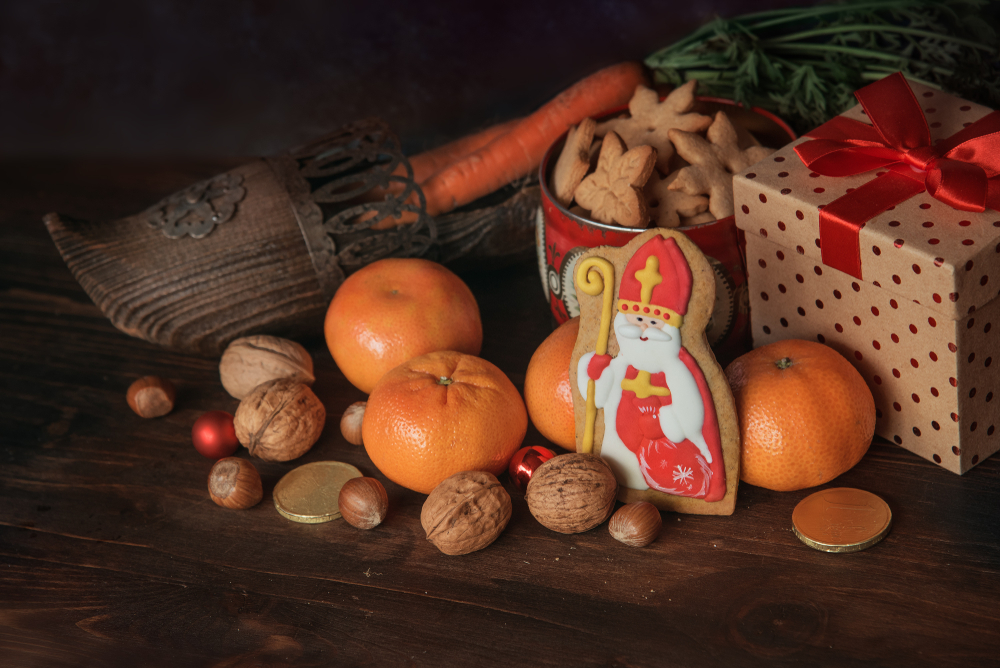Saint Nicholas Day traditions around the world
Saint Nicholas Day traditions around the world
Saint Nicholas Day traditions around the world
-
Hannah
-
Hannah

One story of Saint Nicholas in particular ties in with a very popular tradition. So goes the tale, there was a man who had three daughters, but none of them could marry, because the man was too poor to afford their dowries. One evening Nicholas – who liked to remain anonymous in his gift-giving – climbed to the roof of the man’s house and dropped down the chimney a bag of gold, which landed in a stocking drying by the fire. Thus we hang a stocking in the hope that Saint Nicholas will secretly fill it with gifts.
In many countries Santa visits on 25th December, in line with the celebration of the birth of Jesus, but plenty of places stay true to the original Saint Nicholas and celebrate on 5/6th December in his honour.
Children in the Netherlands, for example, hang stockings on 5th December and leave a carrot out for Saint Nicholas’s horse. The next morning the stocking contains little gifts, and then Sinterklaas visits during the day and leaves larger gifts for good children. In the Czech Republic, Poland and Slovakia children find little presents and chocolates under their pillow or in their shoes. In Hungary, Croatia and Romania, too, children leave out shoes to be filled with little gifts by Saint Nicholas – which relates to his reputedly slipping coins into the shoes that poor people left out.
In some countries Saint Nicholas has companions – a devilish creature, Krampus, who deals with naughty children and an angel for the good ones. The devilish creature may leave a rod/stick for parents to discipline a naughty child. There are even Krampusnacht events in which men dressed up as Krampus march around the streets in terrifying costumes with the aim of spooking children. Certainly a dark side to Saint Nicholas’s Day!
The French are particularly fond of Saint Nicholas. They decorate their homes and bake goodies, including little cakes that are meant to represent him. Traditionally, on 5th December little ones leave their shoes by the fireplace or the door and wake to find them filled with sweeties, and then they go out into the village and wait for a donkey to come by, his baskets filled with gifts, biscuits and chocolates – and perhaps candy canes, which were designed to reflect the bishop’s crozier of Nicholas.
In many places there are important religious traditions associated with Saint Nicholas. In the Orthodox Church of St. Nicholas, for example, a mile from Bethlehem, a divine liturgy is held, followed by a parade. In Albania, Catholics swear by Saint Nicholas, saying “Pasha Shejnti Shen’Kollin!” (“May I see Holy Saint Nicholas!”).
In other places Saint Nicholas’s Day has an altogether more romantic meaning. In Bari, Italy, on 6th December unmarried women can take part in the Rito delle nubile: at an early Mass they go around a column seven times, and this will apparently help them to find a husband. In Sassari, Sardinia, meanwhile, young women who seek husbands are given gifts. This stems from Saint Nicholas being the patron saint of not only children but also virgins (and sailors, merchants, archers, brewers and students, in case you are wondering).
Wherever you are in the world and whatever traditions you may follow today – and later this month, at Christmas – I hope your time is infused with the values that made the memory of Saint Nicholas endure: kindness and generosity and faith.